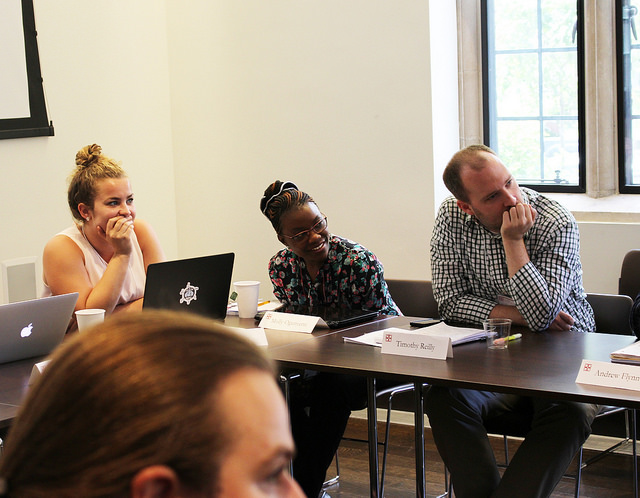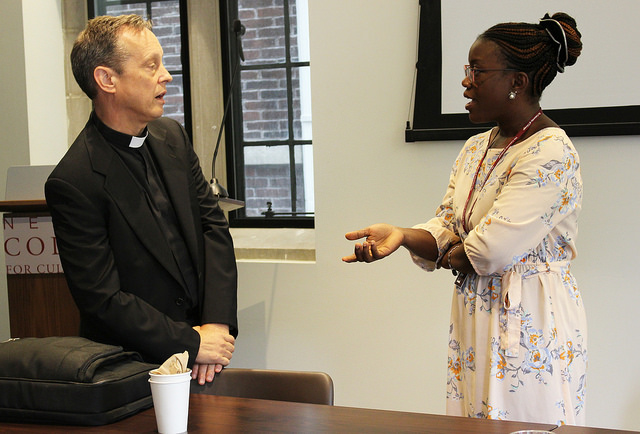
Note: This is part 3 of a 3-part series “Perspective-Taking, Empathy, and Self-Transcendence” based on a talk at the University of California, San Diego by Candace Vogler in June 2018 for WISDOM, COMPASSION, AND LONGEVITY.
Suppose you are ready to undertake the other-perspective form of imagination. There seem to be three crucial aspects of the task. The first is simply activating your capacity for perspective-taking. The second is trying to adjust and correct for the virtually inevitable egocentric bias. And the third is getting accurate information about the other you hope to understand. We can encounter difficulties in any of these three areas.
We can fail to involve ourselves in the task of understanding another person’s perspective because seeing the person’s distress and moving quickly to help can impede any effort to understand how things are from their perspective. In this sense, the kind of image that can inspire us to donate to charities right off may be keeping us from trying to understand the perspective of those whose suffering has us reaching for credit cards. More generally, we can fail to try to understand how things are for the other person because it is harder to try to get a sense for someone else than it is to stick with our own perspective. There is ample evidence that we do what comes easily rather than what takes effort whenever possible.[i] We can substitute the imagine-self variety of perspective-taking for the required imagine-other variety without even noticing ourselves making the shift.
This difficulty is related to a second one—the problem of adjusting for egocentric bias. Even as adults, it can be very hard for us fully to realize that others do not see things the way that we do. If you have ever had a friend who keeps a straight face when teasing others, you likely have a friend who is not always aware that what his target might take the joke seriously. It’s obvious to the teaser that he’s teasing. It is not always clear to the target that she is being teased.[ii] The need to adjust for egocentric biases can arise more than once in imagine-other perspective-taking. Epley and Caruso put the point this way:
[P]eople’s attempts to adopt another’s perspective are likely to retain some residue of their own. When there are few cues that others are likely to see the world very differently, people may not adjust or correct an egocentric bias at all. When the cues are ambiguous and there is some uncertainty about others’ perspectives, attempts to adjust one’s own perspective will tend to be insufficient, and resulting judgments are likely to be egocentric….[iii]
The third hurdle that we need to overcome if we are to engage effectively in imagine-other perspective-taking centers on having accurate information about the other whose experience we are trying to understand. The first two difficulties arise because we are strongly inclined to use ourselves as guides to how things are for others. And, of course, no matter how good I become at imagine-other perspective-taking, the imagination I build for how things are going for you is my imagination at the end of the day. I do not disappear from my own sense of the world just because I am training my efforts on making your situation more vivid for me. What I can do, initially, is draw from the whole field of my experience and understanding to begin to get a sense for you. If you and I have some history together, I can draw from that interpersonal history. I can train myself to notice things about you or yours that are striking and surprising to me—points where our perspectives are likely to diverge. I can practice patience and humility in my efforts to understand you better—listen more than I speak, notice more than I show, and so on. In all of these ways, I can work to develop my capacity for empathy by working to strengthen my capacity for imagine-other perspective-taking.
Empathy and Self-Transcendence
If I am successful in learning how to see how things are for others accurately, then empathy, as I am teaching myself to practice it, can help me to nurture a self-transcendent orientation to the world that we share.
[i] See, for example, Daniel Kahneman, Thinking, Fast and Slow, (New York: Farrar, Straus and Giroux, 2011), Part I, pp.19-108.
[ii] See, for example, Yumi Endo, “Division in Subjective Construction of Teasing Incidents: Role and social skill level in the teasing function,” Japanese Psychological Research, Vol. 49, No. 2, (May 2007), pp. 111-120.
[iii] Nicholas Epley and Eugene Caruso, “Perspective-Taking: Misstepping Into Others’ Shoes,” in Keith Markman, William Klein, and Julie Suhr, editors, Handbook of Imagination and Mental Simulation, (New York: Taylor & Francis Group, 2009), p. 304.
Candace Vogler is Professor of Philosophy at the University of Chicago and a Principal Investigator on ‘Virtue, Happiness, and the Meaning of Life’, a project funded by the John Templeton Foundation. She is also the Chair in Virtue Theory, a joint appointment with the Jubilee Centre and the Royal Institute of Philosophy.






 This post is an excerpt of “Living Within Reason” on the blog “Virtue Insight”, of the Jubilee Centre for Character and Virtue, available here.
This post is an excerpt of “Living Within Reason” on the blog “Virtue Insight”, of the Jubilee Centre for Character and Virtue, available here.

 Candace Vogler is the David B. and Clara E. Stern Professor of Philosophy and Professor in the College at the University of Chicago. She has authored two books, John Stuart Mill’s Deliberative Landscape: An essay in moral psychology (Routledge, 2001) and Reasonably Vicious (Harvard University Press, 2002), and essays in ethics, social and political philosophy, philosophy and literature, cinema, psychoanalysis, gender studies, sexuality studies, and other areas. Her research interests are in practical philosophy (particularly the strand of work in moral philosophy indebted to Elizabeth Anscombe), practical reason, Kant’s ethics, Marx, and neo-Aristotelian naturalism. She is the co-Principal Investigator for the project Virtue, Happiness, & the Meaning of Life.
Candace Vogler is the David B. and Clara E. Stern Professor of Philosophy and Professor in the College at the University of Chicago. She has authored two books, John Stuart Mill’s Deliberative Landscape: An essay in moral psychology (Routledge, 2001) and Reasonably Vicious (Harvard University Press, 2002), and essays in ethics, social and political philosophy, philosophy and literature, cinema, psychoanalysis, gender studies, sexuality studies, and other areas. Her research interests are in practical philosophy (particularly the strand of work in moral philosophy indebted to Elizabeth Anscombe), practical reason, Kant’s ethics, Marx, and neo-Aristotelian naturalism. She is the co-Principal Investigator for the project Virtue, Happiness, & the Meaning of Life.